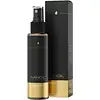What's inside
What's inside
 Key Ingredients
Key Ingredients

No key ingredients
 Benefits
Benefits

 Concerns
Concerns

 Ingredients Side-by-side
Ingredients Side-by-side

Water
Skin ConditioningCyclopentasiloxane
EmollientCyclohexasiloxane
EmollientPhenyl Trimethicone
Skin ConditioningDimethiconol
EmollientPolyquaternium-16
Panthenol
Skin ConditioningPropylene Glycol
HumectantHydrolyzed Wheat Protein
Skin ConditioningHydrolyzed Silk
HumectantPEG-12 Dimethicone
Skin ConditioningHydroxypropyltrimonium Hydrolyzed Wheat Protein
Skin ConditioningLactic Acid
BufferingCetrimonium Chloride
AntimicrobialParfum
MaskingBenzophenone-4
UV AbsorberCI 16185
Cosmetic ColorantBenzyl Salicylate
PerfumingAmyl Cinnamal
PerfumingLimonene
PerfumingCitronellol
PerfumingLinalool
PerfumingGeraniol
PerfumingWater, Cyclopentasiloxane, Cyclohexasiloxane, Phenyl Trimethicone, Dimethiconol, Polyquaternium-16, Panthenol, Propylene Glycol, Hydrolyzed Wheat Protein, Hydrolyzed Silk, PEG-12 Dimethicone, Hydroxypropyltrimonium Hydrolyzed Wheat Protein, Lactic Acid, Cetrimonium Chloride, Parfum, Benzophenone-4, CI 16185, Benzyl Salicylate, Amyl Cinnamal, Limonene, Citronellol, Linalool, Geraniol
Water
Skin ConditioningPhenyl Trimethicone
Skin ConditioningParfum
MaskingDimethicone
EmollientAmodimethicone
Trideceth-7
EmulsifyingTrideceth-5
EmulsifyingTrideceth-12
EmulsifyingHydrolyzed Vegetable Protein
Skin ConditioningAcrylates Copolymer
Propylene Glycol
HumectantHydroxypropylgluconamide
HumectantAcrylates/Beheneth-25 Methacrylate Copolymer
Sodium Hydroxide
BufferingHydroxypropylammonium Gluconate
HumectantPanthenol
Skin ConditioningPhenethyl Alcohol
MaskingCaprylyl Alcohol
MaskingButylene Glycol
HumectantHydrolyzed Corn Protein
Skin ConditioningPEG-7 Glyceryl Cocoate
EmulsifyingHydrolyzed Wheat Protein
Skin ConditioningHydrolyzed Soy Protein
HumectantIodopropynyl Butylcarbamate
PreservativeTartaric Acid
BufferingSaccharomyces/Zinc Ferment
Skin ConditioningSaccharomyces/Copper Ferment
Skin ConditioningSaccharomyces/Magnesium Ferment
Saccharomyces/Iron Ferment
Skin ConditioningSaccharomyces/Silicon Ferment
Skin ConditioningLeuconostoc/Radish Root Ferment Filtrate
AntimicrobialCalcium Pantothenate
Niacin
SmoothingCeramide NP
Skin ConditioningAloe Barbadensis Leaf Juice
Skin ConditioningBetula Alba Leaf Extract
AstringentChamomilla Recutita Flower Extract
MaskingPanicum Miliaceum Seed Extract
Skin ConditioningEquisetum Arvense Extract
AstringentSalvia Officinalis Leaf Extract
CleansingUrtica Dioica Leaf Extract
Skin ConditioningCamellia Sinensis Leaf Extract
AntimicrobialArctium Lappa Root Extract
Skin ConditioningLawsonia Inermis Extract
AntimicrobialHumulus Lupulus Extract
AntimicrobialBiotin
AntiseborrhoeicHydrolyzed Collagen
EmollientDiazolidinyl Urea
PreservativeBenzyl Alcohol
PerfumingDehydroacetic Acid
PreservativeSodium Benzoate
MaskingPotassium Sorbate
PreservativeWater, Phenyl Trimethicone, Parfum, Dimethicone, Amodimethicone, Trideceth-7, Trideceth-5, Trideceth-12, Hydrolyzed Vegetable Protein, Acrylates Copolymer, Propylene Glycol, Hydroxypropylgluconamide, Acrylates/Beheneth-25 Methacrylate Copolymer, Sodium Hydroxide, Hydroxypropylammonium Gluconate, Panthenol, Phenethyl Alcohol, Caprylyl Alcohol, Butylene Glycol, Hydrolyzed Corn Protein, PEG-7 Glyceryl Cocoate, Hydrolyzed Wheat Protein, Hydrolyzed Soy Protein, Iodopropynyl Butylcarbamate, Tartaric Acid, Saccharomyces/Zinc Ferment, Saccharomyces/Copper Ferment, Saccharomyces/Magnesium Ferment, Saccharomyces/Iron Ferment, Saccharomyces/Silicon Ferment, Leuconostoc/Radish Root Ferment Filtrate, Calcium Pantothenate, Niacin, Ceramide NP, Aloe Barbadensis Leaf Juice, Betula Alba Leaf Extract, Chamomilla Recutita Flower Extract, Panicum Miliaceum Seed Extract, Equisetum Arvense Extract, Salvia Officinalis Leaf Extract, Urtica Dioica Leaf Extract, Camellia Sinensis Leaf Extract, Arctium Lappa Root Extract, Lawsonia Inermis Extract, Humulus Lupulus Extract, Biotin, Hydrolyzed Collagen, Diazolidinyl Urea, Benzyl Alcohol, Dehydroacetic Acid, Sodium Benzoate, Potassium Sorbate
Alternatives
Ingredients Explained
These ingredients are found in both products.
Ingredients higher up in an ingredient list are typically present in a larger amount.
We don't have a description for Hydrolyzed Wheat Protein yet.
Panthenol is a common ingredient that helps hydrate and soothe the skin. It is found naturally in our skin and hair.
There are two forms of panthenol: D and L.
D-panthenol is also known as dexpanthenol. Most cosmetics use dexpanthenol or a mixture of D and L-panthenol.
Panthenol is famous due to its ability to go deeper into the skin's layers. Using this ingredient has numerous pros (and no cons):
Like hyaluronic acid, panthenol is a humectant. Humectants are able to bind and hold large amounts of water to keep skin hydrated.
This ingredient works well for wound healing. It works by increasing tissue in the wound and helps close open wounds.
Once oxidized, panthenol converts to pantothenic acid. Panthothenic acid is found in all living cells.
This ingredient is also referred to as pro-vitamin B5.
Learn more about PanthenolParfum is a catch-all term for an ingredient or more that is used to give a scent to products.
Also called "fragrance", this ingredient can be a blend of hundreds of chemicals or plant oils. This means every product with "fragrance" or "parfum" in the ingredients list is a different mixture.
For instance, Habanolide is a proprietary trade name for a specific aroma chemical. When used as a fragrance ingredient in cosmetics, most aroma chemicals fall under the broad labeling category of “FRAGRANCE” or “PARFUM” according to EU and US regulations.
The term 'parfum' or 'fragrance' is not regulated in many countries. In many cases, it is up to the brand to define this term.
For instance, many brands choose to label themselves as "fragrance-free" because they are not using synthetic fragrances. However, their products may still contain ingredients such as essential oils that are considered a fragrance by INCI standards.
One example is Calendula flower extract. Calendula is an essential oil that still imparts a scent or 'fragrance'.
Depending on the blend, the ingredients in the mixture can cause allergies and sensitivities on the skin. Some ingredients that are known EU allergens include linalool and citronellol.
Parfum can also be used to mask or cover an unpleasant scent.
The bottom line is: not all fragrances/parfum/ingredients are created equally. If you are worried about fragrances, we recommend taking a closer look at an ingredient. And of course, we always recommend speaking with a professional.
Learn more about ParfumPhenyl Trimethicone is a silicon-based polymer. It is derived from silica.
Phenyl Trimethicone is used as an emollient and prevents products from foaming.
As an emollient, it helps trap moisture in the skin. It is considered an occlusive.
Learn more about Phenyl TrimethiconePropylene Glycol is an odorless, colorless liquid. As a humectant, it helps skin retain moisture. It also aids in delivering active ingredients.
Another role of this ingredient is preventing a product from melting or freezing. Propylene glycol also adds antimicrobrial properties to a product, elongating product lifespan.
This ingredient is considered an organic alcohol and commonly added into both cosmetics and foods.
Those with sensitive skin or conditions may develop a rash when using this ingredient.
Learn more about Propylene GlycolWater. It's the most common cosmetic ingredient of all. You'll usually see it at the top of ingredient lists, meaning that it makes up the largest part of the product.
So why is it so popular? Water most often acts as a solvent - this means that it helps dissolve other ingredients into the formulation.
You'll also recognize water as that liquid we all need to stay alive. If you see this, drink a glass of water. Stay hydrated!
Learn more about Water